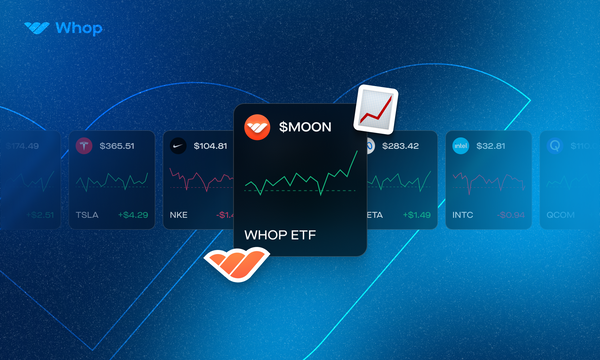Exchange-traded funds have exploded in popularity in recent years thanks to investing’s move into the mainstream. Just about any trading or investing discussion will inevitably lead to ETFs being mentioned, along with the adage that index ETFs always outperform everything else!
So, how do these investing vehicles actually work, and what are they for? Are they really the magic pill that can set every investor up for life? This guide will answer all of these questions, as well as take you through investing in ETFs and what their benefits and drawbacks are.
How do ETFs Work?
We’ll get into how ETFs work under the hood later on in this article, but what’s important for now is that an ETF is made up of a basket of assets. By investing in the ETF, you’re gaining exposure to its contents.
This function is important to a lot of investors raised on the belief that diversification is a crucial strategy when building a portfolio. For those that subscribe to this viewpoint, ETFs are a convenient option since the alternative would be to buy a large number of picked assets in individual trades.
Then there’s also the cost factor. An investor wishing to start small or dollar-cost-average (DCA) as a means of building their portfolio might not be able to buy even one unit of every asset they want. Many stocks cost hundreds of dollars, and not everyone can set aside that much on a regular basis as cost of living continues to balloon.
It’s important to note that you don’t actually own a portion of the underlying assets when you buy an ETF—the firm that you bought the ETF from does. This is one way that ETFs are different from mutual funds, since the latter give you beneficial ownership of the underlying assets.
Unlike mutual funds, though, you can buy and sell ETFs at any time during trading hours. They trade on the exchange just like stocks, and that’s where they get their name.
Types of ETFs
The first way to group ETFs is by whether they’re passive or actively managed. Actively managed ETFs are stewarded by portfolio managers who make the decision when to include and remove assets from the ETF. Some of these portfolio managers can build up a significant following, so marketing can play a part in actively managed ETFs.
Passive ETFs, on the other hand, are designed to follow the performance of a broader index or a specific sector or group of assets. These also have to be managed, in a sense, but the manager or sponsoring firm in charge just has to make sure the underlying assets represent what the ETF is trying to do.
Sector ETFs are a great example of this. If investors think that an industry such as renewable energy is going to prosper in the future, they have the option of looking for an ETF that offers exposure to companies in this space. It’s quite possible to find broad energy ETFs, as well as narrower ones such as renewable energy ETFs, all the way down to specific areas such as solar power ETFs.
That being said, not every ETF needs to be focused on stocks. Commodity ETFs give investors a way to get exposure to other markets, alongside the convenience of staying on more familiar exchanges. Bond ETFs do the same thing, in case you want to build a more classic stock/bond portfolio.
The more modern portfolio with the addition of cryptocurrency to stocks and bonds is a little harder to build using ETFs, but progress is being made. There are now Bitcoin ETFs in play, and more cryptocurrencies may be added in the future if regulators permit.
Finally, you can also find ETFs that can help you carry out more advanced trading strategies. If you wanted to short sell a sector or an index, for example, you could take a position in an inverse ETF. Leveraged ETFs can return much higher profits than a normal ETF, and leveraged inverse ETFs are also a thing!

Are ETFs a Good Investment?
Whether ETFs are a good investment depends very much on what sort of investor you are and what goals you have. Different investors have different strategies, beliefs, and appetites for risk, so ETFs may or may not be the way to go.
Diversification is a philosophy preached by many influential voices, and ETFs are unparalleled in that regard. They can give you exposure to hundreds if not thousands of assets with a minimum of fuss and cash.
Therefore, if you’re the sort who wants an extremely diversified portfolio but don’t have a massive amount of capital to build it with, ETFs may be for you. They’re also going to be an interesting solution if you want to capture the performance of a sector or industry but don’t want to research and buy each individual stock.
Having said which, it may be a good idea to check exactly what assets the ETF is made up of. It’s very possible that you may get poor performance from an emerging markets ETF even though the same markets grow exponentially—it may well be that your ETF contains certain leading companies from those markets, but they themselves had a bad year.
It’s also worth looking into the expense ratio of your ETF when deciding to buy. This isn’t anything more than a yearly management fee, and is expressed as a percentage of the value of a share. As you might imagine, passive ETFs tend to have lower expense ratios than actively managed ones.
Finally, there’s the fact that owning an ETF share doesn’t mean that you own part of the underlying assets. Stocks held in a brokerage account aren’t yours either, but you are at least the beneficial or “street name” owner of those—whereas with ETFs, you’re even further away from owning the actual assets.
Here’s an at-a-glance summary of what you need to keep in mind when it comes to investing in ETFs:
ETF Benefits
- Diversification
- Low cost
- Easy to trade
- Alternate asset exposure
ETF Drawbacks
- Don’t own underlying assets
- May not represent sector perfectly
- Management fees for actively managed ETFs
How to Buy ETFs
You can approach buying ETFs for the most part in the same way as you would buying a stock. Here’s a quick step-by-step guide on how to buy an ETF:
#1. Find a Broker
The first step whether you’re buying stocks or ETFs is to find a venue or platform to do so. You could go with a traditional broker or a neo-broker, and if you’re in doubt, take a look at this list for our picks on the best free trading apps and check if they offer ETFs.
#2. Register For an Account
Once you’ve found a trading app or broker which will give you access to ETF trading, just sign up! This is generally a quick process, although identity verification with a traditional broker could take up to a few days.
#3. Set Trading Strategy
As we’ve mentioned above, ETFs can be great if you want diversification on a budget. They give you the flexibility of index investing, currencies, commodities and even crypto so you’ll need to settle on an investing or trading approach first off in order to narrow down the possibilities.
#4. Conduct Due Diligence
Once you know what sort of ETFs you’re after, you should be down to a smaller list of options. It’s worth devoting a good amount of time researching them, comparing factors like the assets they contain and what their expense ratios are. It’s also a good idea to compare the liquidity that similar ETFs enjoy since illiquid ETFs can be more expensive to get in and out of.
ETFs: Under the Hood
Even though you now know everything about ETFs that concerns investors, you may still be curious about how financial services firms create and maintain them. The main things to know are that ETFs are managed through processes known as creation and redemption, and these are carried out by firms called authorized participants (APs).
The AP first buys the asset that is supposed to make up the ETF, and sells those assets (called a creation unit) to the ETF sponsor or manager in exchange for ETF shares. The AP then goes to the market with their ETF shares and sells them to regular investors. Now, the ETF manager is in custody of the underlying assets and the ETF shares are trading among investors on the market.
Redemption is simply the reverse, and can be used to reduce the supply of ETF shares. The AP buys ETF shares on the market, and sells them back to the ETF sponsor in exchange for the underlying assets.
It must be noted that the AP’s job here isn’t purely functional. The value of the underlying assets, or net asset value (NAV) of the fund, can differ from the price of the ETF share itself. This offers something of an arbitrage opportunity for APs who readily engage in creation and redemption when the ETF shares trade for a premium or discount compared to the fund’s NAV.
Key Takeaways
ETFs, or exchange-traded funds, are one of the easiest ways to diversify an investment portfolio at a low cost. Most investors can’t afford to buy even a small amount of the many assets they’re interested in on a regular basis, but ETFs offer a handy way to do so.
For this reason, ETFs have exploded in popularity. They often come very highly recommended by advocates of diversification in investing. However, ETFs can have drawbacks too. Chief among these may be the fact that they provide no ownership of underlying assets, instead simply offering a way to attain exposure.
➡️ If you’d like to take your knowledge of ETFs to the next level or discuss the ins and outs of different ETFs with other investors, check out Whop.com's trading communities.
🏆 Read next: Top 10 Best Trading Discord Servers


![Top 20 Best Forex Trading Discord Servers [2024]](/blog/content/images/size/w600/2024/05/Top-X-Best-Forex-Discord-Servers.webp)

![Top 25 best trading Discord servers [November 2024]](/blog/content/images/size/w600/2023/08/trading-discord-servers-large.png)
![Top 15 best options trading Discord servers [November 2024]](/blog/content/images/size/w600/2024/05/Top-12-Best-Options-Trading-Discord-Servers-2024.webp)